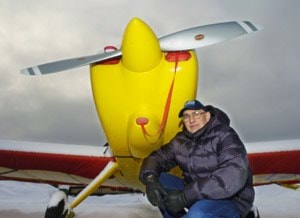George Balmer needs a home for his airplane.
He currently leases a lot at the Whitehorse Airport on which to tie down his plane, but this leaves it exposed to rain, snow and sun.
The $90,000 RV-8, which is the size of a small car, will last longer if he builds a hangar on the lot to protect it from the elements.
The problem is that the city zoning laws for the leased lots at the airport are so contradictory and confusing that Balmer has not been able to build his hangar.
He has been told that he has to maintain a 24-metre setback between his proposed hangar and an adjacent lot, but because his lot is only 19 by 21 metres, the setbacks would make building a hangar impossible.
“The problem is that 10 years ago I would have been able to build a building, leave it three feet from the property line and nobody would have been concerned,” said Balmer. “But right now the city inspectors are telling me that the National Building Code requires these huge setbacks for any structure that I build — the setbacks are larger than my lot.”
Not only are the setbacks too large, but also the distance changes depending on what building materials are used and whether the airplane is loaded with fuel, said city planning manager Mike Gau.
Balmer has been quoted anywhere from 2.4-metre setbacks to 24-metre setbacks.
So the city is considering relaxing the zoning regulations on what is called the “airside” of the airport (the side accessible by aircraft) so that aviators like Balmer can build hangars.
The zoning regulations on airport lots are currently subject to restrictions coming from the government, the national fire and building codes and the city.
Once the regulations are relaxed, the only restrictions on the lots will be set by the national building and fire codes.
“Why there’s a problem up there and complaints about large setbacks is because there is no fire protection in the area — no hydrants or sprinklers or anything, so once those are installed those setbacks will shrink dramatically,” said Gau.
Fire protection is expected to be installed on the airside of the airport in the next few years; in the meantime, the city has to abide by the national code restrictions, said Gau.
The airport’s setup discourages private investment, said Balmer.
He would be willing to build a $60,000 hangar and pay taxes on it if the zoning regulations and required setbacks weren’t so confusing.
“If you fly from here to Lake Laberge, you’ll see a dozen airstrips,” said Balmer.
“Everybody is moving off the airport to private properties and private grass strips because they don’t have the security to build and invest in the airport, so they’re moving to private property where they do have the security. And, if that continues, the only people using the airport is going to be Air Canada.”
Balmer is frustrated the airport, which he calls the gateway to our city, can’t be more organized.
“I have to lease the lot. I have to pay for maintenance. I have to buy insurance on the lot in their name. I have to pay taxes at a commercial rate and yet I’m not allowed to use the lot for commercial activity — basically, all the rules are absurd, they really are.”
